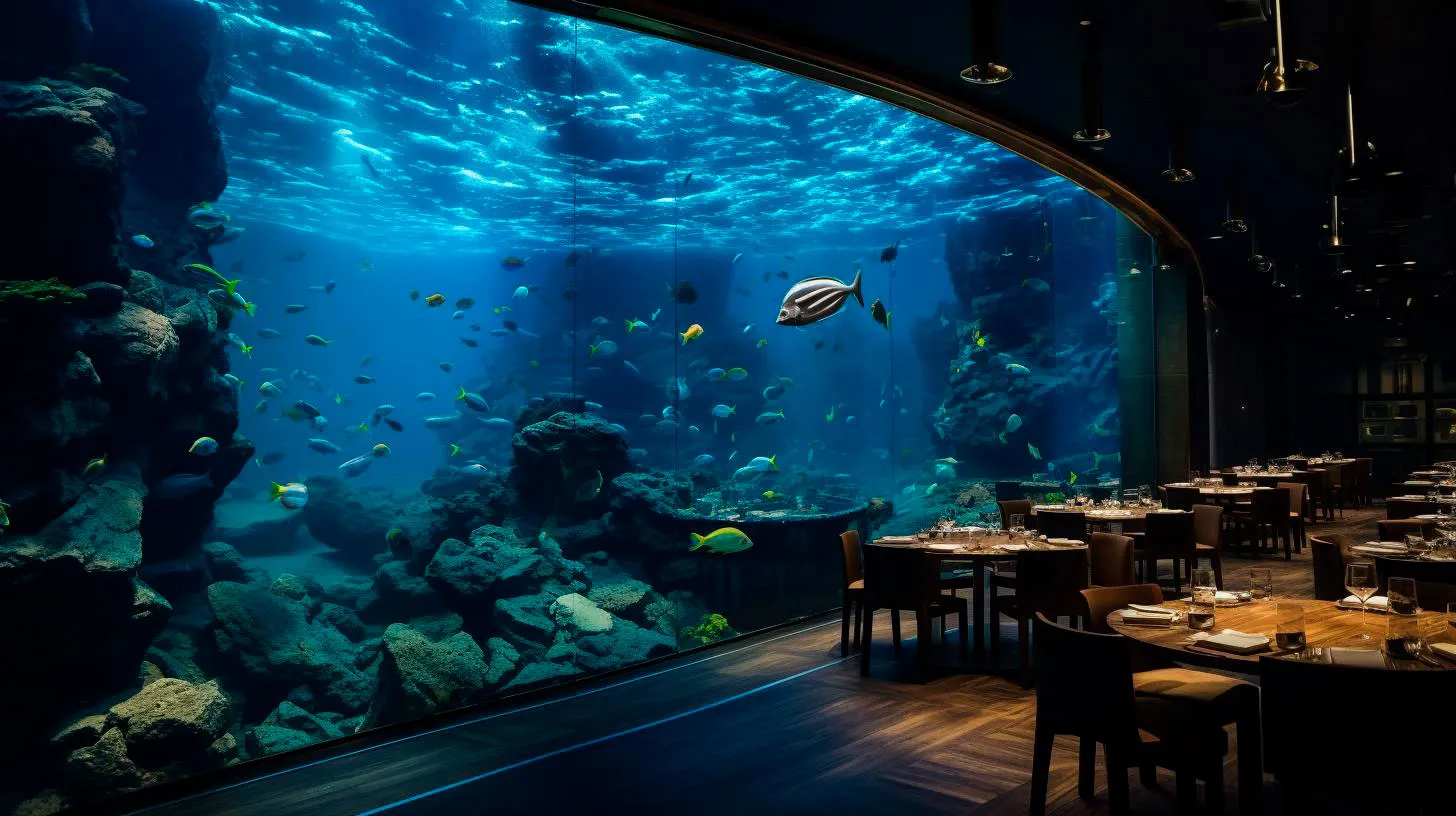Farm to Table: How Sustainable Sushi Supports Local Communities
In this article, we will explore how sustainable sushi practices support local communities while preserving the delicate balance of our oceans.
The Farm to Table Movement
The farm to table movement is a philosophy that emphasizes the use of locally sourced, seasonal ingredients to create delicious and sustainable meals. It aims to reduce the carbon footprint associated with food production and support local farmers and communities. The principles of the farm to table movement resonate strongly with the sushi industry, which relies heavily on fresh seafood and high-quality ingredients.
By embracing the farm to table approach, sushi restaurants can make a positive impact in various ways:
- Sourcing Locally: Sushi establishments can partner with local fishermen and fish farms to obtain freshly caught or responsibly farmed seafood. This not only supports the local economy but also reduces the environmental impact caused by long-distance transportation.
- Preserving Marine Ecosystems: Sustainable sushi practices prioritize the consumption of fish and seafood species that are abundant and not overfished. This approach helps maintain the delicate balance of marine ecosystems and protect vulnerable species from depletion.
- Reducing Waste: Sushi chefs can play their part in reducing food waste by utilizing the entire fish or seafood, including using the bones and scraps for soups or broths. Additionally, they can implement portion control to minimize excess sushi rice and other ingredients.
- Supporting Local Farmers: While seafood is the star of sushi, other ingredients like vegetables, herbs, and rice are equally important. By sourcing these ingredients from local farmers, sushi restaurants can contribute to the growth and sustainability of local agricultural communities.
The Benefits of Sustainable Sushi
Choosing sustainable sushi has significant advantages for both consumers and the environment. Here are some key takeaways:
- Environmental Conservation: Sustainable sushi practices help protect the oceans, maintain biodiversity, and minimize the carbon footprint associated with food transportation.
- Supporting Local Communities: By sourcing ingredients locally, sushi restaurants provide economic support to farmers, fishermen, and other local businesses. This has a positive ripple effect on the entire community.
- Health and Safety: Knowing the source of your sushi ingredients allows you to make informed choices about the quality and freshness of the food you consume. Local sourcing often translates to higher food safety standards and reduced exposure to harmful chemicals.
- Cultural Preservation: Embracing sustainable sushi practices helps preserve traditional fishing and farming techniques, ensuring the continuation of cultural heritage for future generations.
Sustainable Sushi and the Numbers
Let’s delve into some industry statistics to further emphasize the significance of sustainable sushi:
1. Overfishing is a Major Concern
According to the United Nations Food and Agriculture Organization (FAO), nearly 31.4% of the world’s fish stocks are either overfished or have been depleted beyond recovery. These alarming figures highlight the urgent need for sustainable fishing practices within the sushi industry.
2. Sustainable Seafood Certifications are Rising
The Marine Stewardship Council (MSC) and other organizations have developed certifications to ensure the sustainability of seafood. As of 2021, over 20,000 products worldwide carry the MSC label, indicating their compliance with sustainability standards.
3. Local Sourcing Boosts Local Economies
A study conducted by the Seafood Legacy Co. Ltd. in Japan revealed that for every ¥1 million (approximately $10,000) spent on locally sourced seafood, an additional ¥6.6 million (approximately $66,000) is generated within the local economy. This multiplier effect is crucial for the growth and development of coastal communities.
4. Consumer Demand for Sustainable Options
In a survey conducted by GlobeScan and FishChoice, 88% of consumers expressed the desire for sustainably sourced seafood. This increasing demand provides a powerful incentive for sushi establishments to prioritize sustainable practices.
In conclusion, sustainable sushi practices not only benefit the environment but also support local communities and offer numerous advantages to consumers. By embracing the farm to table philosophy, sushi restaurants can make a positive impact on the planet while continuing to delight customers with delicious and responsibly sourced sushi creations.
Preserving Ecosystems: The Impact of Sustainable Fishing on Marine Life
In this blog post, we will explore the impact of sustainable fishing on marine ecosystems and discuss the various strategies and technologies employed to promote sustainable fishing.
The Challenge of Overfishing
Overfishing remains one of the most significant threats to marine life. According to the United Nations, approximately 90% of the world’s fish stocks are either fully or overexploited. This unsustainable fishing practice not only depletes fish populations but also disrupts the delicate balance of marine ecosystems.
The negative consequences of overfishing are far-reaching and include:
- Species extinction: Overfishing can push certain fish populations to the brink of extinction, disrupting the natural food chain and leading to imbalances within ecosystems.
- Loss of biodiversity: As a result of overfishing, certain species dominate while others decline, leading to a loss of overall biodiversity within marine environments.
- Economic impacts: Over time, depleting fish stocks can have severe economic consequences, affecting the livelihoods of coastal communities that rely on fishing for their income.
The Benefits of Sustainable Fishing
Sustainable fishing practices aim to mitigate the negative impacts of overfishing and preserve marine ecosystems for future generations. By adopting sustainable fishing methods, we can achieve a delicate balance between harvesting fish and allowing populations to replenish.
Some key benefits of sustainable fishing include:
- Preservation of fish stocks: Sustainable fishing limits catch rates, allowing fish populations to recover and maintain a healthy balance within ecosystems.
- Protection of marine biodiversity: By targeting specific species and implementing fishing quotas, sustainable practices help prevent the extinction of vulnerable marine species and preserve overall biodiversity.
- Support for local communities: By adopting sustainable fishing, we can ensure the long-term viability of fishing communities, providing them with a secure source of income while safeguarding their way of life.
Promoting Sustainable Fishing Practices
Various strategies and technologies have been developed to promote sustainable fishing practices and mitigate the negative impacts of overfishing. Let’s explore some of them:
1. Fishing Quotas and Regulations
Government-imposed fishing quotas and regulations play a crucial role in sustainable fishing practices. By setting catch limits and implementing seasonal restrictions, authorities can control the intensity of fishing, allowing fish populations to recover and thrive.
2. Selective Fishing Techniques
Selective fishing techniques such as using specific mesh sizes in nets or using hooks instead of trawling can help minimize bycatch. By reducing the unintentional capture of non-target species, selective fishing techniques contribute to preserving biodiversity and minimizing ecosystem disruption.
3. Technology Innovations
Advancements in fishing technologies have revolutionized sustainable fishing practices. From the use of satellite-based monitoring systems to identify and track fishing vessels to the introduction of Fish Aggregating Devices (FADs) that attract specific fish species, technology plays a crucial role in reducing the environmental impact of fishing.
4. Adoption of Fish Farming
Aquaculture or fish farming offers an alternative to traditional fishing methods, helping reduce pressure on wild fish stocks. By cultivating fish in controlled environments, aquaculture provides a sustainable and predictable source of seafood, reducing the need for excessive fishing in natural habitats.
The Road to a Sustainable Future
The future of our oceans and marine life depends on our collective efforts to adopt sustainable fishing practices. By promoting awareness and implementing effective strategies, we can work towards preserving ecosystems and ensuring the long-term viability of our fisheries.
In conclusion, sustainable fishing is not only essential for the well-being of marine ecosystems but also for the survival of our own planet. By embracing sustainable fishing practices, we can protect marine biodiversity, support coastal communities, and secure a future where humans and marine life can thrive together.
Remember, adopting sustainable fishing practices is the responsibility of every individual. Together, we can make a difference and preserve the wonders of our oceans for generations to come.
Ocean Responsibly Sourcing Sustainable Seafood for Sushi
It has become crucial to ensure that our love for sushi doesn’t contribute to unsustainable fishing practices and harm our oceans.
The Importance of Sustainable Seafood Sourcing
Sourcing seafood responsibly is vital for maintaining the delicate balance of our marine ecosystems. Overfishing, destructive fishing methods, and the depletion of certain species can have severe consequences on the health of our oceans. By choosing sustainably sourced seafood for our sushi, we can help protect marine habitats, support local fishing communities, and safeguard the future of our oceans for generations to come.
The Challenges of Sourcing Sustainable Seafood
Sourcing sustainable seafood for sushi comes with its own set of challenges. The global seafood supply chain is vast, making it difficult to trace the origins of our favorite fish. Additionally, different species have different levels of sustainability, making it crucial to stay informed about the best choices for both our palates and the planet.
- Complex seafood supply chain
- Different levels of sustainability
- Need for consumer education
The Role of Certification Programs
Certification programs have emerged as a valuable tool in promoting responsible seafood sourcing. These programs, such as the Marine Stewardship Council (MSC) and the Aquaculture Stewardship Council (ASC), provide guidelines and certifications for sustainable fishing practices and responsible aquaculture. By looking for these certifications when purchasing seafood for sushi, we can be confident that we are making an eco-conscious choice.
- Marine Stewardship Council (MSC)
- Aquaculture Stewardship Council (ASC)
- Guidelines for sustainable fishing and aquaculture
Embracing Local and Seasonal Seafood
Opting for locally sourced seafood is another way to support sustainability efforts. When we choose fish harvested from local waters, we reduce the carbon footprint associated with long-distance transportation. Additionally, consuming seafood that aligns with the natural seasonal cycles helps prevent overfishing and allows species to regenerate their populations.
- Reduced carbon footprint
- Preservation of natural seasonal cycles
- Regeneration of fish populations
Collaboration with Sustainable Fishing Communities
Collaboration between sushi restaurants and sustainable fishing communities is key to ensuring the responsible sourcing of seafood. By establishing direct relationships with local fishermen who prioritize sustainable practices, sushi establishments can have greater control over the quality and sustainability of the seafood they serve. This partnership helps support local economies and encourages the continuation of sustainable fishing practices.
- Direct relationships with local fishermen
- Greater control over seafood quality
- Support for local economies
Consumer Education and Empowerment
Empowering consumers with knowledge about sustainable seafood is essential for driving change. Sushi lovers can educate themselves about the most sustainable options and make informed choices when dining out or purchasing seafood for homemade sushi. By spreading awareness and supporting establishments that prioritize sustainable sourcing, we can collectively make a significant positive impact on the health of our oceans.
- Educating consumers about sustainable seafood choices
- Supporting establishments with sustainable sourcing practices
- Collective positive impact on oceans
In Conclusion
Satisfying our sushi cravings shouldn’t come at the cost of our oceans’ health. By responsibly sourcing sustainable seafood for sushi, we can revel in the flavors of this beloved cuisine while protecting the marine ecosystems that provide us with such culinary delights. By supporting certification programs, embracing local and seasonal options, collaborating with sustainable fishing communities, and educating ourselves as consumers, we can ensure a sushi experience that is not only delicious but also environmentally responsible.
Let’s make a conscious choice for our sushi and for our oceans!
Future of Sushi Innovations Driving Sustainability in the Sushi Industry
In this article, we will explore the future of sushi innovations and how they are driving sustainability in the sushi industry.
The Rise of Sustainable Fishing Practices
One of the key challenges facing the sushi industry is maintaining a steady supply of fish without depleting marine resources. Traditional fishing methods often involve overfishing and destructive practices that harm the environment. However, in recent years, there has been a shift towards sustainable fishing practices that prioritize the preservation of marine ecosystems.
Key Takeaway: The rise of sustainable fishing practices ensures that our oceans and marine life are protected for future generations.
The Emergence of Plant-Based Sushi Options
In an effort to reduce reliance on traditional fish sources, the sushi industry has seen the emergence of plant-based sushi options. These innovative alternatives use a variety of plant-based ingredients such as tofu, mushrooms, and vegetables to recreate the flavors and textures of traditional sushi.
Key Takeaway: Plant-based sushi options not only offer sustainable alternatives to traditional sushi but also cater to the growing demand for plant-based diets.
Advancements in Aquaculture
Aquaculture, or fish farming, has become an important solution in meeting the demand for sushi while minimizing the environmental impact. Innovations in aquaculture techniques have led to the development of sustainable fish farming practices that ensure the health and well-being of farmed fish, while also minimizing the use of antibiotics and chemicals.
Key Takeaway: Advancements in aquaculture help to reduce overfishing and dependence on wild-caught fish, making sushi more sustainable and accessible.
Technological Innovations in Sushi Preparation
Technology is playing a significant role in driving sustainability in the sushi industry. There have been several innovations in sushi preparation techniques that not only enhance efficiency but also reduce waste. For example, sushi robots are now being used in restaurants to automate the sushi-making process, reducing the time and labor required.
Key Takeaway: Technological advancements in sushi preparation help in reducing waste, improving efficiency, and maintaining consistency in taste and quality.
Packaging Solutions for a Sustainable Future
The sushi industry is also exploring sustainable packaging options to minimize its environmental footprint. Traditional sushi packaging often involves single-use plastic containers and excessive packaging materials. However, there is a growing trend towards eco-friendly alternatives such as biodegradable packaging made from materials like bamboo or recycled paper.
Key Takeaway: Adopting sustainable packaging solutions helps in reducing waste and minimizing the environmental impact of the sushi industry.
Conclusion
The future of sushi innovations is undeniably driving sustainability in the sushi industry. From sustainable fishing practices to plant-based alternatives and technological advancements, the industry is taking significant steps towards a more sustainable future. By embracing these innovations and incorporating them into their practices, sushi restaurants and suppliers can not only meet the growing demand for sushi but also contribute to the preservation of our oceans and marine life.


